Oh, Man! Cycling In The Jewel Of The Middle East
So you think riding in a desert is going to be just heat and sand? Welcome to Oman, where rugged landscapes, awesome gravel tracks, smooth tar and majestic mountains make for an epic three-day trip.
This adventure was supposed to be another girls’ trip with my trusted cycling buddy Kimi, until she injured her knee skiing. Searching for a last-minute replacement, I had to field questions like: “Will you wear a scarf? Will you cover up on the bike? Will we be allowed to share a room if we’re not married? Are women allowed to drive?”
But it was easy to persuade work colleague Neil to stand in for Kimi, and we were back on track for another adventure in one of the most unlikely places you’d ever think of riding a bike.
I was there to file yet another story for XPDTN3.CLUB – a website dedicated to three-day touring adventures from around the world.
As it’s located on the south-eastern end of the Arabian Peninsula, with the United Arab Emirates, Saudi Arabia and Yemen as its neighbours, it’s no surprise that the Sultanate of Oman is often overlooked as a travel destination. But put aside any preconceptions of the region, and you will find a tranquil, peaceful country – a true treasure chest of adventure, hospitality and scenery.
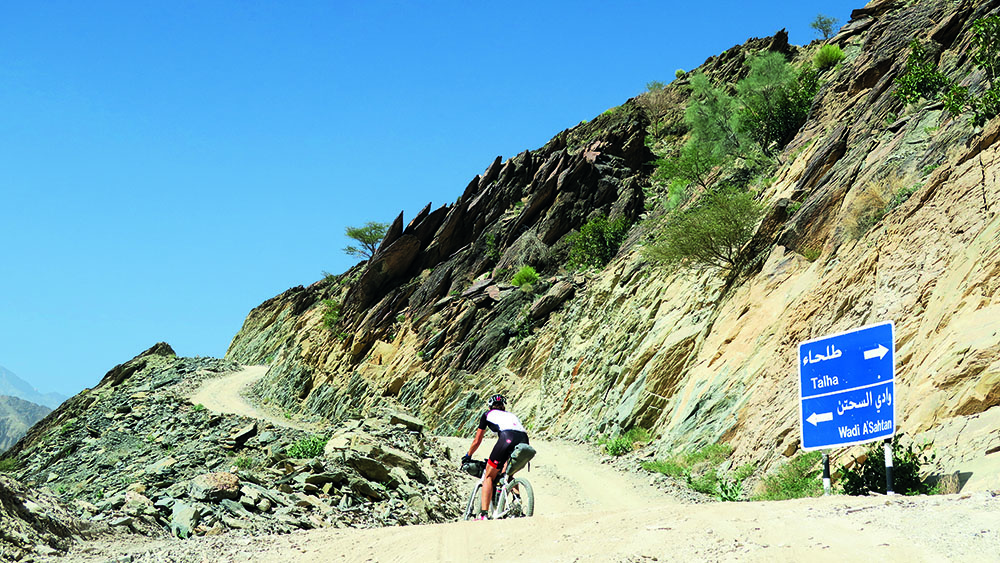
A short six-hour direct flight from most major European cities to the capital, Muscat, makes Oman the perfect winter escape. It’s a jewel of the Middle East.
The Al Hajar Mountains lie to the north-west. Some 70km from the coast, Jebel Shams is Oman’s highest mountain, peaking at an imposing 3 002m. In the summer months, the area is popular with Omanis looking to escape the brutal heat of the lowlands. Ideal conditions for cycling occur in the European winter, through December and January.
It proved trickier than anticipated to work out the perfect three-day trip: it had to allow us to travel light while taking in the highlights, and provide maximum variety. And though the area features plenty of villages for filling up on water and food, accommodation is seriously limited outside the major business centres and away from the few tourist hubs.
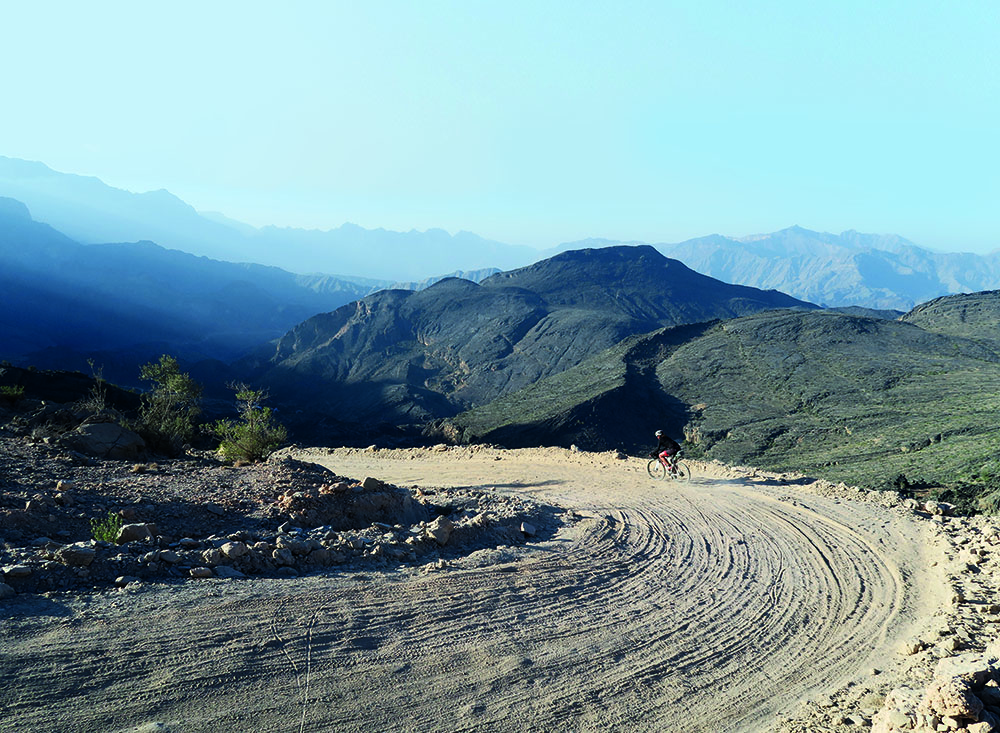
Researching route options exhaustively on Google Earth, I felt more like an astronaut than a cyclist – but after several nights of poring over my PC, we were finally ready to embark on our adventure: “Ground control to Major Tom… take your protein pills and put your helmet on…”
DAY 1: MURRI-JEBEL SHAMS 101.2km 2 397m
It was still dark as we drove to Murri, a tiny village tucked into the mountains just off Route 10 between Rustaq and Ibris, to strategically park the rental car for our return three days later. This was going to be our biggest day; and with somewhat unreliable estimates on what terrain and just how much climbing was to be expected, a dawn start made sure we had a buffer.
Which turned out to be a good call. Shortly after rolling out of Murri, the terrain changed to a narrow wadi with lots of short, sharp climbs that didn’t feature on the profile, making for slow progress. Was Google, which notoriously overstates the climbing metres, going to be accurate after all?
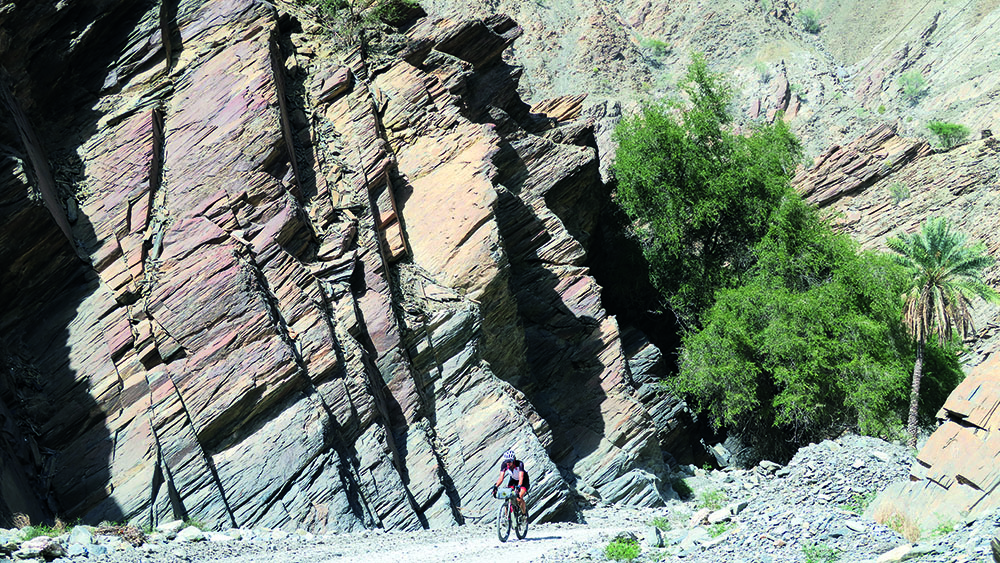
As the wadi widened and the sun began to peek over the mountains, we approached a small town – and a wide tar road, with almost no traffic other than a few construction vehicles. As the road carved through the mountainside, our GPS log drew a straight, thick line over the former winding track – a telling clue as to the rate of development in Oman.
The country continues to invest billions of US dollars in road infrastructure; and at the rate they’re going, I recommend you visit Oman sooner rather than later, while there are still gravel roads to enjoy!
With the light waning, and the final 18km and 1 300m ascent up the Jebel Shams Road ahead, we wisely declined a coffee invitation from a friendly local, who was intrigued by our tyre-fixing efforts.
Initially, we were disappointed that the first 10km of the climb is now tarred, but we soon thanked our lucky stars – this ascent rivals iconic European climbs such as Mont Ventoux and Alpe d’Huez.

After lots of grimacing and zigzagging across the (thankfully) wide road, we eventually made it to the top just before sunset. Wanting to catch the last rays, we rode on to the closest viewing point for the ‘Grand Canyon of Arabia’ – Wadi Ghul, dropping a thousand metres into a stunning abyss.
Also dropping dramatically was the temperature, and by the time we finally reached our accommodation we were frozen solid. The incredibly hospitable staff at Sama Heights couldn’t believe that anyone would actually cycle up their mountain. Highly impressed, they promptly upgraded our accommodation.
A scrumptious buffet dinner in the cosy hotel restaurant made us feel on top of the world. Oh, wait – we were. On top of Oman, anyway.
DAY 2: JEBEL SHAMS-WADI BANI AWF 96.2km 1 991m
We spent the morning exploring the magnificent viewing points along the rim of the canyon. The ‘balcony trail’ is popular with hikers; but don’t attempt this on a bike, with luggage, unless you’re Danny MacAskill. Or suicidal.
After the sun pushed the temperature back into the double digits, we claimed our reward for the previous day’s efforts – the descent towards Al Hamra.
Which was amazing, but there were noises coming from our disc brakes that I’d never heard before. Neil assured me the noises would go away if I just braked less (huh?), and that they were to be expected when one’s brakes run very hot. We used them as an excuse to stop for more photos.
Al Hamra is one of Oman’s oldest towns, with wonderfully green palm trees and rows of traditional mud-brick houses. It’s also the perfect spot to refuel before tackling the next climb, from 700m altitude right back up onto the ridge to the Sharfat al Alamayn viewpoint at 2 000m.
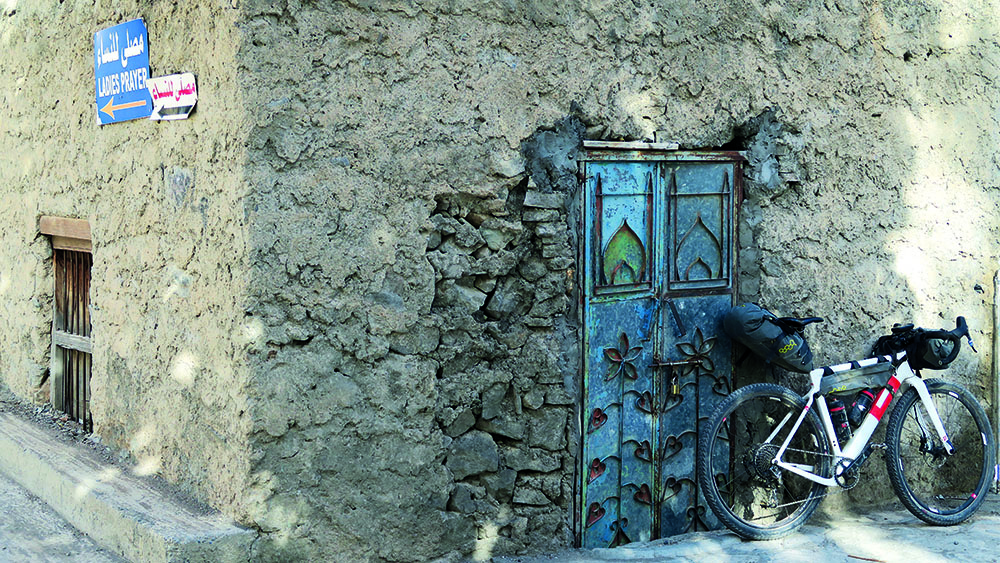
The road to the top is tarred and offers a pleasant gradient, compared to the previous day’s ascent. At the top, however, this all changes. Out next section of ‘road’, we discovered, is graded four-wheel-drive only, and it plummeted (at some scary gradients) to the traditional mountain oasis of Hatt, and into Wadi Bani Awf.
In mountain biking, you’re often told to ‘get your ass behind your saddle’ when descending steep sections – but it’s not that easy, when you’re carrying a saddle pack filled with gear…
On the one hand we just wanted to blast down, all white knuckles and pumping adrenaline. But this section is a geological wonder, absolutely awe-inspiring – we felt as though we were in a scene from Star Wars. Around every corner there was yet another view to make us stop (generally, with a long skid) to take in the astonishing scenery.
Once again we rolled into camp with only the last rays of daylight to guide us. Nestled deep in a fold in the mountains, Bait Bimah Travel Lodge offers basic accommodation with shared bathrooms, but is immaculately clean.
DAY 3: WADI BANI AWF–MURRI 86.6km 1 597m
The next morning, we backtracked a few kilometres to visit Bilad Sayt – an idyllic little village tucked into a side gorge. If you can (it just means cycling faster than we did the previous day!), I recommend visiting during the afternoon, as the light should be better for photos.
The final day was meant to be easy – at least, that’s what the profile suggested. So we decided to take another quick side trip to the lower entry into Snake Canyon, with its steep, towering walls. But halfway there, one look at the descent (knowing we’d have to come up again, which would probably take a good hour and involve walking), we decided it was wiser to rejoin the route to Wadi Sahtan and press on with our journey.
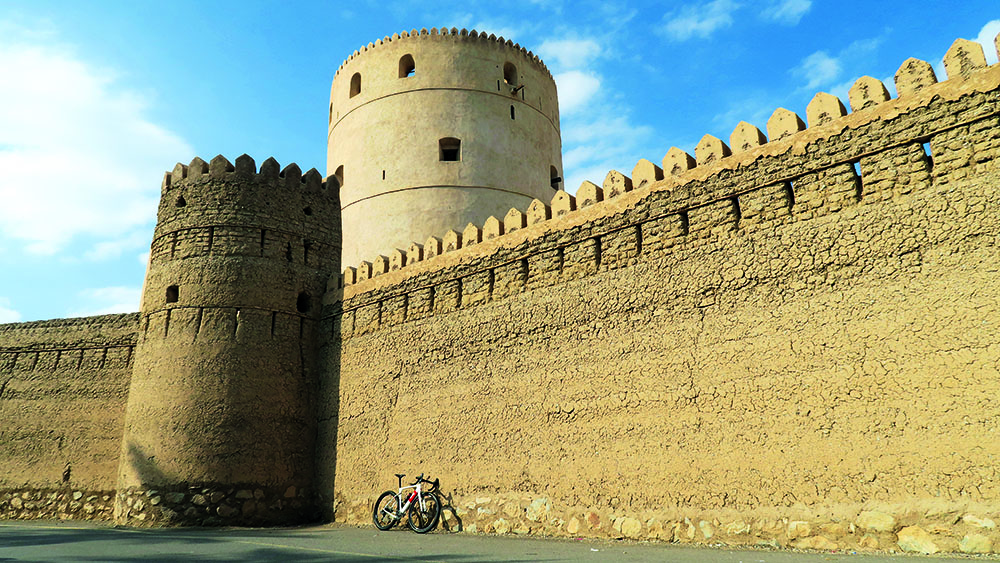
Just as well. We had underestimated what we thought was a ‘little spike’ in the profile – only two kays long, but it was brutally steep. As the road pointed towards heaven while putting us through hell, we pondered the road signs for Wadi Sahtan, with (like many place names in Oman) its variations in spelling…
Wadi Sahtan itself was everything and more that we could have hoped for. After the previous days’ desert and high-mountain riding, we found ourselves in a narrow riverbed with flowing water, and Jebel Shams towering above us. It seemed we couldn’t escape the presence of this mountain.
Popping out of the wadi, we were – abruptly – back in civilization, on yet another oversized tarred road, for such light traffic. However, the scenery was no less spectacular.
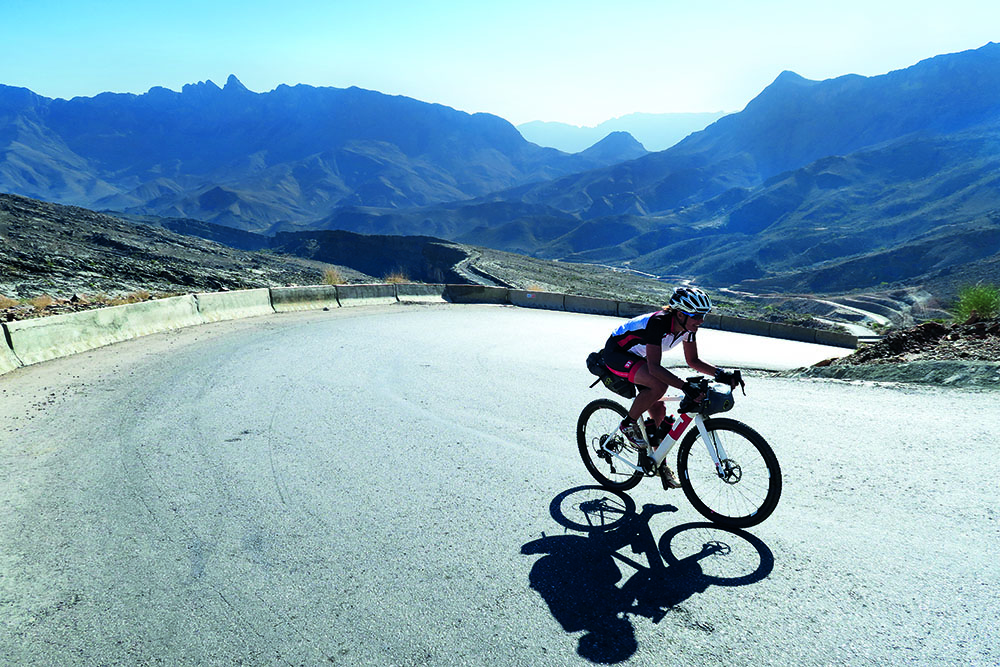
At this point, we came close to hitting the wall – figuratively as well as literally. As we were following the main road, we missed our usual village shops; but we assured ourselves that ‘there’ll be another one soon’.
There wasn’t. It didn’t help that during the afternoon, almost everything is closed. Between 12pm and 4pm (when temperatures are around 45 degrees, in summer) there’s not a person in sight. Before we knew it we were back on lonesome gravel tracks, skirting the foot of the mountain range – the vast contrasts never ceased to amaze.
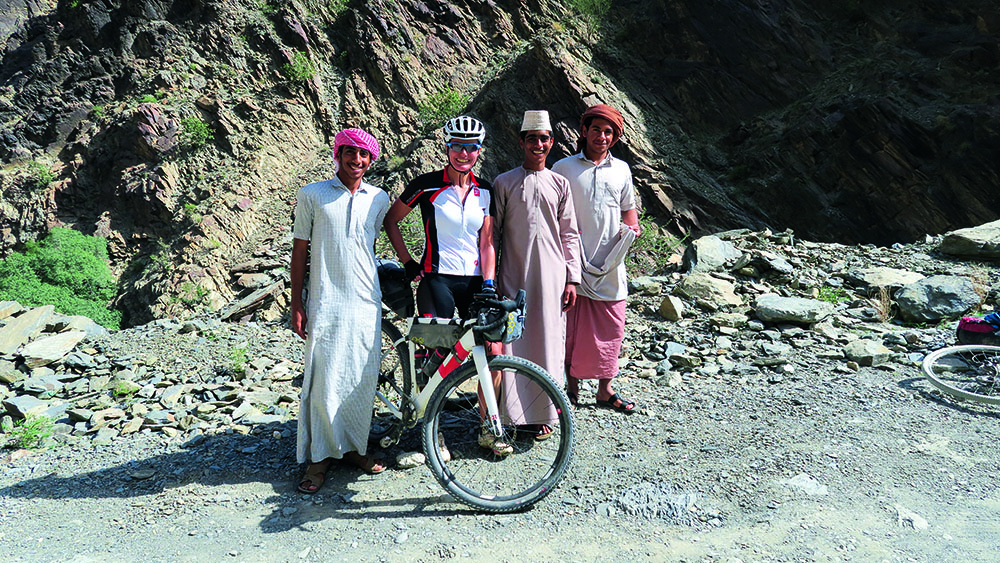
With the short daylight hours, once again we were racing the sunset back to our rental car in Murri, to get us back to Muscat for a sumptuous dinner.
While guzzling down our well-earned four-course meal, we reflected on what were (and will surely remain) three of the most remarkable days of cycling we’ve ever had.
Location: Oman Al Hajar Mountains
Stages: 3
Distance: 285km
Climbing: 7 170m
Best Time: Winter (Dec/Jan). Do not attempt in summer!
Terrain: Flat and fast tar, to rugged, steep gravel roads. Ideal for gravel bikes.
Weather: Sunny and dry. Temps range from mid 20’s to zero at high elevations.
Bike: 3T Exploro with 11/42T gearing. I was glad that at the last minute, I downsized to a 34T. I figured there’s no need to pedal when you’re travelling faster than 40km/h. Save your gears for the climbs!
Food: You’ll come across many small stores advertising Food Stuff For Sale: Don’t let the strange signs put you off – we enjoyed some delicious roadside food, and fun interactions with the people!
Water: Drinking water is freely available. In the vicinity of mosques you’ll usually find a tap, and there’s bottled water in the shops.
READ MORE ON: cycling in oman oman travel

